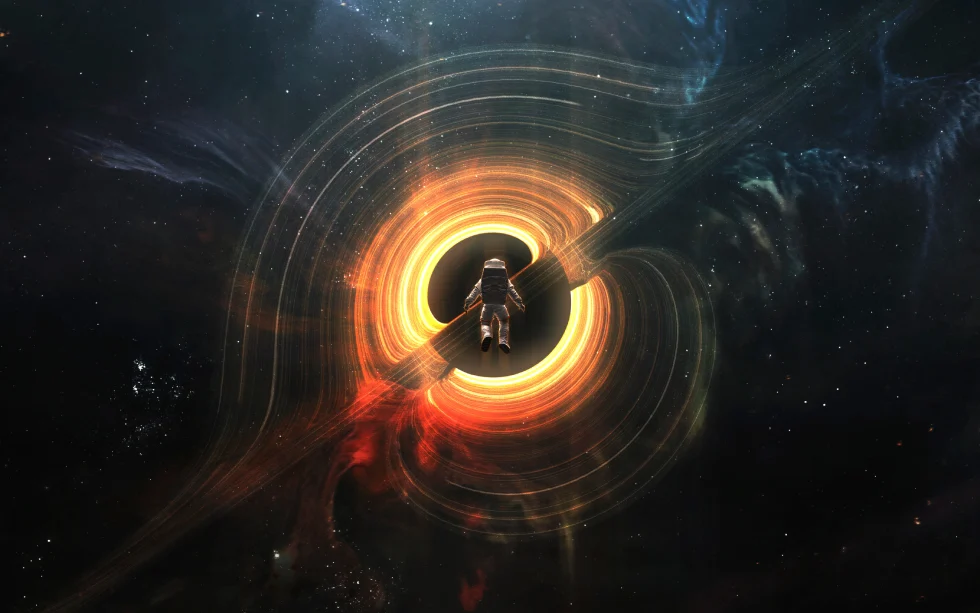Theoretical physicist Albert Einstein famously doubted that gravity was a force. In 1915, he posited that gravity was not a force but rather an effect of the warping of space and time in the presence of mass. Though an unorthodox idea in his time, this proved revolutionary. Einstein’s theory of general relativity showed mathematically that gravity is not really a force of attraction between all objects with mass, as 17th-century physicist Isaac Newton thought.
Newton thought that gravity was like magnetism. He gave us the following equation for gravity:

Via Dna-Dennis on Wikimedia Commons (CC BY 3.0).
With the advent of modern physics, the scientific community reduced apparently diverse phenomena — like electricity, magnetism, tension, friction etc. — to four fundamental forces: gravity, electromagnetism, the weak nuclear force and the strong nuclear force. Scientists believe these are responsible for all observations of energy-matter interactions.
However, gravity behaves differently from the other three. Further, general relativity has resisted all attempts to harmonize it with quantum physics, which explains the other three forces. Mounting evidence suggests that gravity is not a force at all. If true, this breakthrough could solve one of the oldest problems in physics.
What we currently know about gravity
According to some astrophysicists, the problem is that quantum theory still cannot adequately explain gravity. We don’t know how to calculate gravity’s behavior at the high energies or small scales where particles exhibit their inherently quantum nature.
Attempts to explain gravity using quantum physics — “quantum gravity” — present a hypothetical particle called a graviton. The graviton determines the force of gravity on a thing. Because of a mathematical issue, no full quantum field theory exists about gravitons. Similarly, there is limited understanding of how the quantum field that underpins gravity — assuming one exists — behaves at all under any circumstances.
For this reason, one might think that gravitons under quantum mechanics may be virtual, meaning they’re difficult to detect and don’t follow expected patterns. However, gravity waves have been observed, proving their existence.
With that said, researchers are postulating intriguing observations at the microscopic level. These fascinating suggestions could potentially reconcile the disconnect between gravity and quantum mechanics.
Some 100 years ago, Einstein proposed an effect called “gravitational lensing.” According to his theory, a strong gravity field, such as those created by a star or galaxy, should bend light and create something akin to a lens. Some interpret this phenomenon as the result of gravitational pull by these massive bodies. Others may explain it as being the result of the dependent force of gravity on cosmic energy and warpage, caused by the curvature of space. Either way, the effect is now widely used to peer behind massive objects throughout outer space.
In 2018, the US-based Laser Interferometer Gravitational-Wave Observatory (LIGO) and European Virgo detector made an amazing discovery. Scientists directly detected gravitational waves — which LIGO describes as “ripples in space-time” — as well as light generated from a neutron star collision. The scientific community had never before seen a cosmic event in gravitational waves and light.
A contentious solution
Now to discuss a rather contentious hypothesis within the scientific community Gravity may be a dependent force. Since quantum theory fits other observed forces but not gravity, the issue may be that gravity simply is not an independent force.
Energy and matter are inextricably intertwined, with energy comprising an estimated 75% of the known universe. Perhaps all primary forces are subsets of energy under a unified theory.
Scientists have observed that the currently estimated 13.8 billion-year-old universe, with its billions of galaxies, gravitational black holes, neutron stars and other massive objects, continues to expand at an accelerating rate. This constant acceleration, combined with the warping curvature of space and time, could be the cause of gravity. This concept would be consistent with Einstein’s theory, but extended to a larger, rapidly expanding framework.
The prevailing scientific opinion in the 1920s held that the universe was static. When Einstein tried to produce a general theory of relativity, he found that it seemed to predict an eventual gravitational collapse of the universe — a concept now commonly called the Big Crunch. To produce a model in which the universe was static and stable — which Einstein then believed was the proper result — he introduced the cosmological constant, a mathematical “fudge factor” labeled “Λ” (the Greek letter, lambda). Then in 1929, astronomer Edwin Hubble discovered that the observable universe was, in fact, expanding. Confronted with this new knowledge, Einstein called his proposed cosmological constant “the biggest blunder of [his] life.”
However, this may not have been such a massive mistake, if our verified assumption concerning the universe’s accelerating expansion were to replace his “static universe” assumption. Perhaps an updated Gravitational Constant (GC) that quantifies and explains the dependent nature of gravity on the warpage of space could modify the “G” in the earlier equation.
Each answer raises more questions
Where do we go from here? If we assume the above hypothesis that gravity is just a dependent force, all primary forces could be concordant with quantum mechanics. Perhaps the answer is that all assumed forces are dependent forces — dependent on cosmic energy and the warpage caused by the curvature of space.
Additionally, dark energy and dark matter still need to be sufficiently defined. Perhaps that is our equivalent fudge factor to Einstein’s. It could explain the lack of observed mass in the universe and energy required for an accelerating and expanding universe, and therefore gravity.
Quantum physics presents us with obstacles. But with every discovery we make, we come closer to fully understanding the truth of our universe.
[Beaudry Young and Lee Thompson-Kolar edited this piece.]
The views expressed in this article are the author’s own and do not necessarily reflect Fair Observer’s editorial policy.
Support Fair Observer
We rely on your support for our independence, diversity and quality.
For more than 10 years, Fair Observer has been free, fair and independent. No billionaire owns us, no advertisers control us. We are a reader-supported nonprofit. Unlike many other publications, we keep our content free for readers regardless of where they live or whether they can afford to pay. We have no paywalls and no ads.
In the post-truth era of fake news, echo chambers and filter bubbles, we publish a plurality of perspectives from around the world. Anyone can publish with us, but everyone goes through a rigorous editorial process. So, you get fact-checked, well-reasoned content instead of noise.
We publish 3,000+ voices from 90+ countries. We also conduct education and training programs
on subjects ranging from digital media and journalism to writing and critical thinking. This
doesn’t come cheap. Servers, editors, trainers and web developers cost
money.
Please consider supporting us on a regular basis as a recurring donor or a
sustaining member.
Will you support FO’s journalism?
We rely on your support for our independence, diversity and quality.









Comment